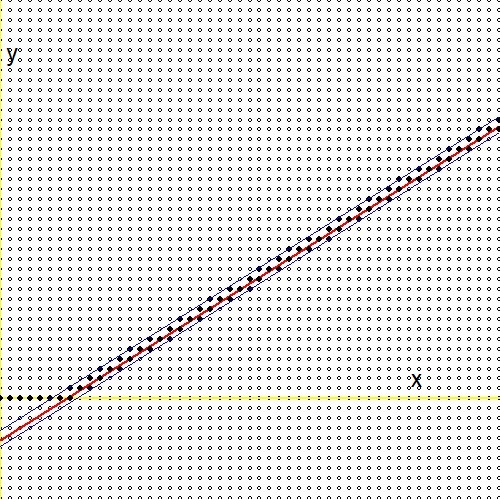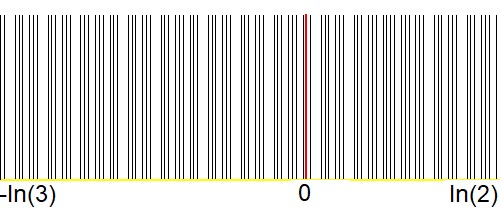
program apart;Output:
procedure test(r : double; eps : double); var a : double; m,n : integer; begin a := 1; m := 0; n := 0; while true do begin if a < r then begin m := m + 1; a := a * 2; end else begin n := n + 1; a := a / 3; end; if abs(r-a) < eps then Break; end; Writeln(r,' = 2^',m,'/3^',n,' =',a); end;
begin test(sqrt(2),1.E-3); end.
1.41421356237310E+0000 = 2^243/3^153 = 1.41493657935359E+0000UPDATE.
Note. The question can also be formulated as: Can any positive real be approximated as $3^m/2^n$ with $(m,n)$ large enough? Which is the same as allowing negative integers with the original formulation. In this form, it shows some resemblance to the (in)famous Collatz problem.
EDIT.
As suggested by the answers, an approach with logarithms could be more effective:
program anders;Output:
procedure proef(r : double; eps : double); var a,l2,l3,lr : double; m,n : integer; begin l2 := ln(2); l3 := ln(3); lr := ln(r); a := 0; m := 0; n := 0; while true do begin a := m*l2 - n*l3 - lr; if abs(a) < eps then Break; if a < 0 then m := m + 1 else n := n + 1; end; Writeln(r,' = 2^',m,'/3^',n,' =',exp(a)*r); end;
begin proef(sqrt(2),1.E-3); proef(sqrt(2),1.E-9); end.
1.41421356237310E+0000 = 2^243/3^153 = 1.41493657935356E+0000 1.41421356237310E+0000 = 2^911485507/3^575083326 = 1.41421356125035E+0000The first line in the output is almost identical to the result obtained previously .
Continuing story at:
Can the Stern-Brocot tree be employed for better convergence of $2^m/3^n$?
So what we have is a bunch of fractions, all different, but they must fit within the interval $\,]r/3,2r[\,$. This means that the fractions become crowded. Let's make a picture of the iteration process, logarithmic version. The red line is given by $\,\color{red}{\ln(3)y=\ln(2)x-\ln(r)}\,$, small circles are fractions, mapped on a grid $\,m/n \to (m,n)\,$, massively black filled dots are the fractions in the iteration process, while increasing $m$ and $n$ with increments one at a time. The iterations domain is limited by: $\,\color{blue}{-\ln(2)\lt\ln(3)y-\ln(2)x+\ln(r)\lt\ln(3)}\,$. In our case $r = 100$. Mind the sequence at the start.

So it seems that there must be quite some fractions nearby the red line, rerpesenting the real number $r$ in question.
How can we be sure about this? Let's make picture of the crowding of the approximations $a$ in the interval $\,]r/3,2r[\,$,
logarithmic scale:
$$
a = m\ln(2)-n\ln(3)-\ln(r) \quad \mbox{with} \quad -\ln(3) < a < \ln(2)
$$
The red line is where $a = 0$, the desired value.

Further numerical/graphical experiments reveal that the distribution of the fractions seems to be uniform. While seeking further confirmation of this we have done the following, speaking in terms of (Delphi) Pascal:
program opnieuw;Explanation. Make random intervals $\,]A,B[\,$ inside $\,]-\ln(3),+\ln(2)[\,$. The length of the latter interval is $\,\ln(3)+\ln(2)=\ln(6)\,$, the lenghs of the former are $\,(B-A)\,$. Count the (logarithms $x$ of the) fractions $\,(2^n/3^n)/r\,$ in both intervals. Let $N$ be the total number (tel) of iterands and $n$ be the number (t) of iterands in $\,]A,B[\,$. Then the distribution of the approximations $x$ is uniform if and only if: $$ \lim_{N\to\infty}\frac{n}{N} = \frac{B-A}{\ln(6)} $$ Let's check. Output after a billion iterations each line:
procedure interval(var A,B : double); var h : double; begin A := Random; B := Random; if A > B then begin h := B; B := A; A := h; end; end;
procedure proef(r : double); const veel : integer = 1000000000; var x,l2,l3,lr,A,B : double; m,n,tel,t : integer; begin l2 := ln(2); l3 := ln(3); lr := ln(r); interval(A,B); A := -l3 + A*(l2+l3); B := -l3 + B*(l2+l3); m := 0; n := 0; tel := 0; t := 0; while tel < veel do begin x := m*l2 - n*l3 - lr; if x < 0 then m := m + 1 else n := n + 1; if (-l3 < x) and (x < +l2) then tel := tel + 1; if (A < x) and (x < B) then t := t + 1; end; Writeln((B-A)/(l2+l3),' = ',t/tel); end;
begin Random; Random; proef(1000); proef(0.001); proef(sqrt(2)); proef(1/sqrt(2)); while true do proef(Random); end.
6.58467502100393E-0001 = 6.58467500000000E-0001 3.98733151378110E-0001 = 3.98733149000000E-0001 1.56895805848762E-0001 = 1.56895804000000E-0001 5.34354087430984E-0002 = 5.34354050000000E-0002 4.04224734520540E-0001 = 4.04224734000000E-0001 2.33572337077931E-0001 = 2.33572341000000E-0001 4.06758418539539E-0001 = 4.06758418000000E-0001 1.46495995344594E-0001 = ....But how can we prove that it is a uniform distribution?